From Beaufort West, we drove steadily east and as our morning unfolded, the Karoo’s unflinching dryness mellowed out and slowly gave way to 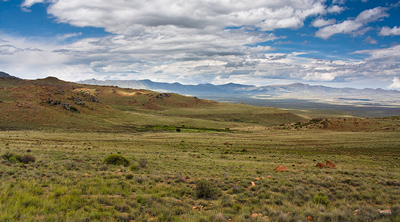 encouraging traces of vegetation. By the time we’d reached the town of Graaff Reinet, two-thirds into our daily leg, green had appeared all around us in a surprising display of tenacity. There had been much rain recently and we were witnessing its almost instantaneous effect on the landscape. Roads were flanked with high fluid grass waving in the wind and fields had turned from barren to lush.
encouraging traces of vegetation. By the time we’d reached the town of Graaff Reinet, two-thirds into our daily leg, green had appeared all around us in a surprising display of tenacity. There had been much rain recently and we were witnessing its almost instantaneous effect on the landscape. Roads were flanked with high fluid grass waving in the wind and fields had turned from barren to lush.
We continued northwards through a series of narrow mountain ranges of medium elevation until we found our turn to the west and into rolling hills of the most amazing green hues. The tar gave way to dirt, we slowed down to observation speed and left civilization behind as we climbed over the hills and disappeared into the remote countryside of Nieu Bethesda.
Some 20 km later, on a very winding path that finally descended into a luxuriant valley, a few houses and a church tower materialized below us. Of Nieu Bethesda, we knew very little apart from the fact that it was home to the strange Owl House. From the village – I still resist calling it a town – our instructions were to head north for another 10 km at which point we would reach our destination, the Doornberg Farm.
We looked around us curiously as we cruised through a few 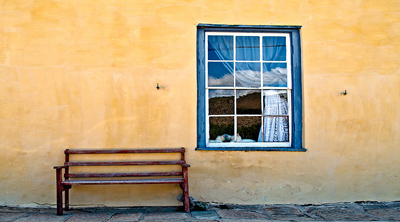 tree-lined dirt streets, taking in the old houses and their quaint gardens, a soft afternoon quietness, the curious exclusive use of white pick-ups called bakkies and the unavoidable crumbling shacks at the edges of town. This probably was prime farm land. Lots of open space despite the bumps, few people to share it, a seeming abundance of water. The sheep looked happy. I wasn’t so sure about the few people I saw.
tree-lined dirt streets, taking in the old houses and their quaint gardens, a soft afternoon quietness, the curious exclusive use of white pick-ups called bakkies and the unavoidable crumbling shacks at the edges of town. This probably was prime farm land. Lots of open space despite the bumps, few people to share it, a seeming abundance of water. The sheep looked happy. I wasn’t so sure about the few people I saw.
The Doornberg Farm is so literally part of the countryside that the public dirt road runs right through it on its way to elsewhere. Following some signs, we branched off towards a group of sheds and a large house resting in the protective shadow of a gigantic oak tree.
We were greeted by our hosts Hanna and Peet who welcomed us in and offered coffee and rusks, as it is customary on a South African late afternoon. Peet then launched into a long introduction of the farm, telling us more than we could absorb about his sheep, their sturdiness, an aborted attempt at supplying Woolworth’s with organic lamb and many eye-opening facts about the cost of farming and the reality of feed lots. It was all fascinating and he obviously cared deeply for his work, but we were tired and anxious to settle in our cottage for a rest.
The cottage we had booked for one night, called the Vleihuisie, was isolated far away from the main house in the fields and the farmer led us there at high speed in his white bakkie, negotiating the narrow muddy path like a rally driver. After a few kilometers, a low-lying stone house appeared at the foot of pepper trees, the body of an old WW2-era car rusting melancholically in pretty grass nearby. 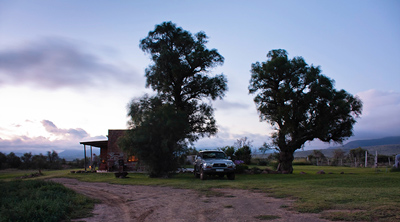 Marie and I looked at each other incredulously: there was nothing else around. This was almost too good to be true.
Marie and I looked at each other incredulously: there was nothing else around. This was almost too good to be true.
The cottage was sitting right in the middle of vast lucerne fields in the progress of being harvested. A tractor was slowly plowing its way through a flock of beautiful storks resting on their long migratory journey. The old but carefully renovated little house was nested against three ponds and a small enclosure into which sheep and their endearing lambs were drinking from a tub.
Peet showed us around the cottage and then left to go tend to the harvesting. We unpacked with a growing sense of peace, already regretting not to stay longer than a night. The place was well decorated, very well equipped for full self-catering, perfectly comfortable and cozy, had a working fireplace, plenty of space, couches, chairs everywhere, a spacious bathroom with a tub and a shower, and no one around for many kilometers. The rental cost was R400 a night, which came up to about US $50 for two people. It was going to be the best deal of our trip.
The farmers had told us of a braai place they’d carved right out of the ground, far into the dry veld on a plateau where only short plants grew, and after settling in, we decided to get back on the Landcruiser and investigate. To get to that remote spot, we had to venture deep into farm land, opening and closing many stock and game fences along the way and driving slowly through puddles in the dirt road.
When we found it, a simple circular hole with a central plate dug straight into the very hard orange soil, we looked around us, sweeping the horizon for 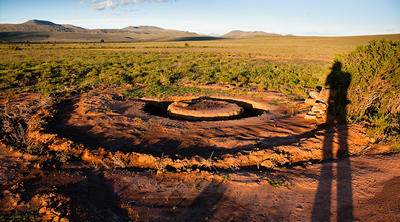 signs of anything like us. There were none. Our cottage was far out of sight, the farm even further so, and only a few bokkies could be seen fleeing in the distance. The silence and isolation were almost ocean-like. We were standing in the middle of a dry sea of greens and reds, its gentle rolling waves forever frozen in a final spontaneous pose.
signs of anything like us. There were none. Our cottage was far out of sight, the farm even further so, and only a few bokkies could be seen fleeing in the distance. The silence and isolation were almost ocean-like. We were standing in the middle of a dry sea of greens and reds, its gentle rolling waves forever frozen in a final spontaneous pose.
It was late and the sun was now rushing to greet the antipodes; we stayed and enjoyed the perfect peace as the day came to a beautiful end. Then we drove back to the warmth of our shelter’s inside lights and Marie prepared to braai on the porch while I walked away from the house to take pictures of the solitude.
We slept like babies and in the morning, while sipping on strong stove-top espresso coffee and despite having already agreed on a road plan for the day towards our next stop Ladybrand, we caught ourselves lingering and resisting the need to pack. The feeling of peace had worked its way to our bones and all we needed to stay was an excuse.
That was easy to find; this was February 17th. Our next booking was three days later in Lesotho. We had allowed for three driving days to get there and were hoping to find camping or cheap accommodation along the way. But that wasn’t much more than 700 or 800 km and even on unknown roads, we confidently could cut the ride short one day. We’d head towards 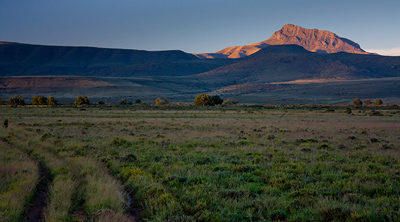 Ladybrand the following morning, and would still make Lesotho on the 19th.
Ladybrand the following morning, and would still make Lesotho on the 19th.
So we stayed at the cottage. We checked in with our hosts, advising them of our decision and buying lamp chops from the source for the night’s braai, and then headed back down the dirt road to investigate Nieu Bethesda.
Parking the truck in the shade, we set out to explore a few dusty streets that form the heart of the small town. Very few cars were in sight and the place felt half-asleep. We found the post office/souvenir/coffee shop and went in to mail postcards. A few local ladies were engaged in a conversation at the counter and the post-mistress was nodding right and left.
I stood aside, sizing the place up and browsing the shelves, while Marie approached the group. I wasn’t paying much attention to the ongoing conversation even though it was held in English, and before I could catch up with what had been said, I realized Marie was jumping in and addressing an older lady in a very reproachful tone. “You cannot say that!” she said bluntly. I glanced at her. Her face was flushed and angry.
Everyone else went quiet while the two argued. I pieced the situation together the best I could and figured the woman had used a forbidden word, one that belonged to South Africa’s troubled past, a word ever-loaded with racism and intolerance and forever banned by enlightened South Africans, by the ones who had emerged from a long hatred tunnel into relative sunlight and moderate justice. She had called a colored man a kaffir.
I only knew of the word because of reading The Power of One, and hadn’t realized how loaded a weapon it was. The verbal fight escalated. The lady was throwing wild accusation at people she obviously hated and finally barked at Marie: “You’re not even South African,” as if it meant you’re not 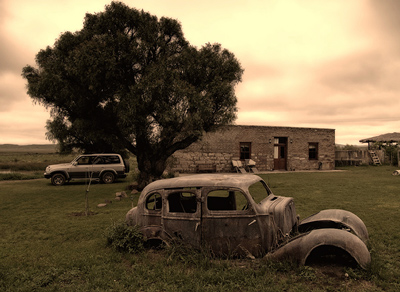 part of the issue, or you don’t deserve to speak. “Actually I am, born and raised in Bloemfontein!” Marie fumed, losing the little bit of control she had left. I put my hand on her shoulder but she didn’t even feel me and stormed outside after a last altercation, refusing the post-mistress’ offer to mail her postcards.
part of the issue, or you don’t deserve to speak. “Actually I am, born and raised in Bloemfontein!” Marie fumed, losing the little bit of control she had left. I put my hand on her shoulder but she didn’t even feel me and stormed outside after a last altercation, refusing the post-mistress’ offer to mail her postcards.
I followed her, distractedly feeling the sun’s bite as we stepped into the street, and I attempted to support and encourage and understand and stand by, while being acutely aware that I was left far behind and outside of a very sensitive issue. Marie was shaking. I had rarely seen her so upset. She had lived in South Africa during the dark ages, while a pale Mordor ruled over the land with an iron fist of absolute racial discrimination, and she could not bear to see the past awakened.
We walked around for a while until a pick-up truck drove up to us and we recognized one of the ladies who had witnessed the post office scene. “I’ve come to apologize for our town,” she said with a friendly but embarrassed smile. “We‘re not all like that.” Marie took a deep breath. This was a welcomed relief. “She‘s a frightened old lady,” the woman added, “they are all on drugs and commit much petty crime. They have tried to break in her house repeatedly.”
We thanked her and moved on. The apology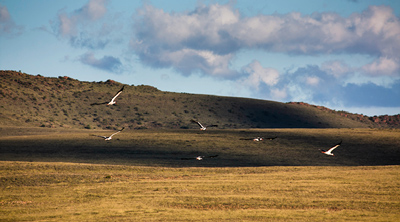 was sincere, and yet had left us with a sense of unresolved trouble. “We” as in the rest of themmight not all have been “like that”, but it still seemed they understood and might even have agreed.They just wouldn’t have had the guts to use the forbidden word to express such discomfort with the opposite race.
was sincere, and yet had left us with a sense of unresolved trouble. “We” as in the rest of themmight not all have been “like that”, but it still seemed they understood and might even have agreed.They just wouldn’t have had the guts to use the forbidden word to express such discomfort with the opposite race.
The scars of Apartheid were nowhere more visible than in this small town that we had thought to be much more progressive. We later learned, while having lunch at a nice joint that served homemade cheeses and sausages, that there actually was an “other” Nieu Bethesda, like anywhere else in South Africa, just a few hundred meters away. It turns out that despite our literature advertising the town as having no available supplies – “Bring everything with you,” we had been cautioned – one only needed to cross over to the other side and go to a spaza*.
We then visited the Owl House, giving the town a chance to redeem itself. It was just strange. An alienated artist named Helen Martins had once had hundreds of bizarre cement sculptures built and arranged in her garden. She was now dead but the house remained and has been turned into a quirky museum. She probably had been going cuckoo. Her vision was eccentric. But then again, maybe eccentricity was a prerequisite to be an artist and to live in such a place.
Returning to the cottage was a balm on our chafed emotions. We walked through the fields and took pictures of the silence. The night was chilly and we opted to cook and eat inside. While dinner was on the oven, I stayed out and stared at the stars for a long time, lost in thoughts. They were all there, all my friends, my favorite constellations united in the same sky even though part of different stories.
There were the Gemini, Castor and Pollux. There was Orion the Hunter and his two dogs, protecting the seven sisters from the mean bull. Betelgeuse and Aldebaran shone their giant red eyes at me while Sirius, brightest object in the Earth’s sky, glowed with a cold and shimmering white. There was my dear Southern Cross and its two trailing stars, which, along with Canopus and Achernar, allowed for the actual south celestial pole to be found.
And there was me, down here, infinitely small but reaching out to touch them, arrogantly confident, like all human beings, until I 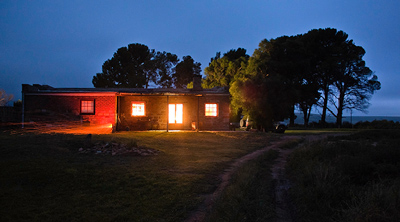 looked up and remembered that I knew nothing. That day, I had just received another involuntary lesson in all things South African. Somehow, though, I didn’t feel like I understood anything better. It was saddening and humbling, but the truth is, it was still out of my grasp. I wondered if I ever would reach the breaking point of enlightenment on South African racial matters.
looked up and remembered that I knew nothing. That day, I had just received another involuntary lesson in all things South African. Somehow, though, I didn’t feel like I understood anything better. It was saddening and humbling, but the truth is, it was still out of my grasp. I wondered if I ever would reach the breaking point of enlightenment on South African racial matters.
They are so easily judged and categorized on the surface: everyone knows that racism, in all its forms or tendencies, is evil and to be banned from our society. That’s the easy judgment part. But then arises a need to understand the causes. And as Tolkien said it so well, “All That is Gold Does Not Glitter.” When it comes to racism and its politics, so many intricate levels of complexity are involved that one might get lost along the way.
If we, for a moment, decide to accept all human beings as equal and thus as having some good and some bad inside of them, then racism becomes a complex two-way challenge where both victims and oppressors could begin to share blame and merit, and Power emerges as the only real oppressor, one that ironically is fueled not by strength but by fear. Still, defining racism – and this isn’t a pun – is a black and white matter. It’s simple. There is good and there is evil. One hates and stands on the side of evil. One tolerates and joins the good side.
But then, when sides have been taken, as we insist on digging deeper, black and white and evil and good blend into each other, and the human race emerges in all its messed up complexity, and suddenly, there is nothing left but shades of grey.
* A spaza is an informal convenience store, probably without a proper license and run from home, a shack or a container, selling goods and food in the townships where proper stores may not be available.
For the record and a great story, here is Marie’s take on the event.
«Cartwheels Over Lesotho» Series
Want to read the entire series of stories? Start here
Already reading sequentially?
Previous story: Cartwheels over Lesotho, Part 1 – War and Peace in the Karoo
Next story: Cartwheels over Lesotho, Part 2b – Nieu Bethesda, last moments
Marie’s recount: Kruger National Park
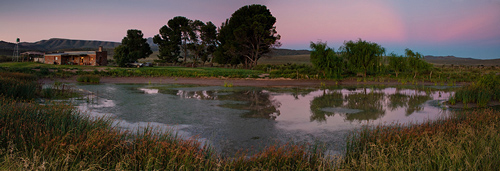
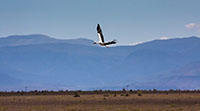
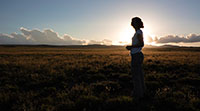
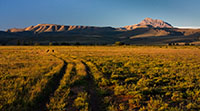
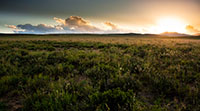
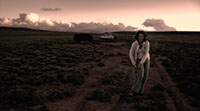
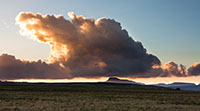
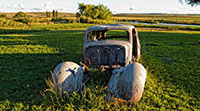
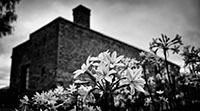
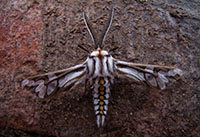
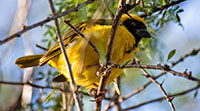
Comments
Anyes
bonbon oiseau
frank@nycgarden
dinahmow
Vince